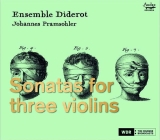 Sonaten für drei Violinen; Sommer: Der 8. Psalm; Fontana: Sonata 16; Buonamente: Sonate Nr. 2; Pachelbel: Canon & Gigue; Torelli: Sonate für 3 Violinen; Fux: Sonate für 3 Violinen; Dornel: Sonate en quatuor; G. Gabrieli: Sonate Nr. 21 für 3 Violinen; Purcell: 3 Parts upon a Ground & Pavane; Schmelzer: Sonate für 3 Violinen; Baltzar: Pavane; Hacquart: Sonate Nr. 10; Ensemble Diderot, (Johannes Pramsohler, Roldán Bernabé, Simone Pirri, Violine, Gulrim Choï, Cello, Philippe Grisvard, Cembalo und Orgel); 1 CD Audax ADX13729; Aufnahme 01/2020; Veröffentlichung 30/04/2021(79'56) – Rezension von Uwe Krusch
Sonaten für drei Violinen; Sommer: Der 8. Psalm; Fontana: Sonata 16; Buonamente: Sonate Nr. 2; Pachelbel: Canon & Gigue; Torelli: Sonate für 3 Violinen; Fux: Sonate für 3 Violinen; Dornel: Sonate en quatuor; G. Gabrieli: Sonate Nr. 21 für 3 Violinen; Purcell: 3 Parts upon a Ground & Pavane; Schmelzer: Sonate für 3 Violinen; Baltzar: Pavane; Hacquart: Sonate Nr. 10; Ensemble Diderot, (Johannes Pramsohler, Roldán Bernabé, Simone Pirri, Violine, Gulrim Choï, Cello, Philippe Grisvard, Cembalo und Orgel); 1 CD Audax ADX13729; Aufnahme 01/2020; Veröffentlichung 30/04/2021(79'56) – Rezension von Uwe Krusch
Die CDs vom Label Audax machen einen immer süchtig. Das liegt zuallererst daran, dass das Papier des Beiheftes beim Entfalten einen intensiven Geruch ausstrahlt. Sicherlich wird der einen gerne daran schnüffeln, der andere mag sich abwenden. Doch es liegt auch oft genug, wie hier, an der Musik.
Während die Triosonate zwei Melodieinstrumente, also beispielsweise zwei Geigen mit dem Continuo gruppiert, sind es hier drei Violinen zur Bassgruppe. Das eröffnet völlig neue Möglichkeiten bzw. vorher Anforderungen an Komponisten. Stehen sich zwei Gegenüber, ist ein Wettstreit programmiert, der eher ein Gegeneinander oder Abwechseln nahelegt, so dass es auch mehr in reinen Streit als Wettstreit ausarten kann. Bei drei führenden Stimmen müssen neue Balancen gefunden werden, in denen sie miteinander reden, oder zwei gegen den dritten, oder oder.
Eine große Zahl der Werke für drei Geigen entstanden gleichzeitig mit der Emanzipation der Geige nach der Gambenfamilie. Außerdem hatte seit Monteverdi die emotionale Darstellung Einzug in die Musik gehalten und die Geige mit ihren Ausdrucksmöglichkeiten passte gut darein. Und schließlich entwickelte sich auch parallel die Sonate. Wobei sie technisch im Sinne eines Formschemas als auch untechnisch im Sinne rein instrumentaler Musik verstanden werden sollte. Nimmt man alle diese Elemente, so finden sich in etwa einem Jahrhundert von 1600 bis 1700 zahlreiche Beispiele.
Das Ensemble Diderot mit seinem Inspirator Johannes Pramsohler hat sich bei diesem Album wieder einem Konzept, hier dieser Besetzung, gewidmet. Wieweit die vielen Johann und Giovanni bei den Komponisten auf den geigenden Johannes anziehend wirken, weiß ich nicht. Aber zumindest scheint die Nähe zur und die Begeisterung für die Musik nicht zu enden. Mit Roldan Bernabé und Simone Pirri hat Pramsohler zwei ihm Vertraute gefunden, die sich dem gemeinsamen Ziel ebenso vertraut und engagiert annehmen. Sie entwickeln so enge und sich umwebende Klangkonstruktionen, dass ein nur Zuhörender nicht einzuordnen wagt, wer wer ist und wer welche Stimme spielt. So wird genau der gewünschte Effekt erzielt, dass hier drei miteinander agieren und freundschaftlich um Töne ringen und nicht ihren eigenen Vorteil suchen.
Wie immer aufmerksam begleitend und gestaltungswillig und eben nicht nur zuverlässig grundierend spielen Gulrim Choi am Cello und Philippe Grisvard Cembalo und Orgel. Die Aufnahmequalität ist reizvoll klar, ohne zu separieren und luftig direkt, ohne aufdringlich zu werden.
The CDs from the Audax label are always addictive. Right after unpacking them, this is first and foremost due to the fact that the paper of the booklet emits an intense smell. Certainly, one person will like to sniff it, the other may turn away. But the fascination is also often enough, as here, due to the music.
While the trio sonata has two melody instruments, for example two violins with the continuo, here there are three violins to the bass group. This opens up completely new possibilities, and before that, demands on composers. If there are two opposites, a competition is programmed, which rather suggests a counterpart or alternation. With three leading voices, new balances must be found in which they talk to each other, or two against the third, or or.
A large number of works for three violins were written simultaneously with the emancipation of the violin after the viola da gamba. In addition, since Monteverdi, emotional representation had entered music, and the violin with its expressive possibilities fit in well. And finally, the sonata developed in parallel. Whereby it should be understood technically in the sense of a formal scheme as well as non-technically in the sense of purely instrumental music. If one takes all these elements, one can find numerous examples in about a century from 1600 to 1700.
The Ensemble Diderot with its inspirer Johannes Pramsohler has dedicated itself again to a concept, here to this instrumentation. I don’t know to what extent the many Johann and Giovanni among the composers are attractive to Johannes playing the violin. But at least the closeness to and enthusiasm for the music does not seem to end. In Roldan Bernabé and Simone Pirri, Pramsohler has found two people familiar to him who are equally familiar and committed to the common goal. They develop such tight and interweaving sound constructions that a mere listener does not dare to classify who is who and who plays which voice. In this way, exactly the desired effect is achieved, that here three are acting with each other and amicably wrestling for tones and not seeking their own advantage.
As always, Gulrim Choi on the cello and Philippe Grisvard on the harpsichord and organ play with attentive accompaniment and willingness to shape the music, not just reliably grounding it. The recording quality is delightfully clear and homogeneous.
























